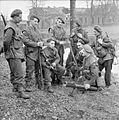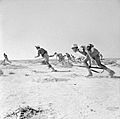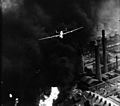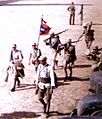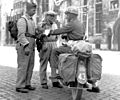Allies of World War II facts for kids
Quick facts for kids
Allies of World War II
United Nations
|
|
|---|---|
| 1939–1945 | |
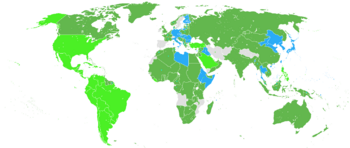
The "Big Four":
Occupied countries with governments-in-exile:
Other Allied combatant states:
|
|
| Status | Military alliance |
| Historical era | World War II |
| 31 Mar 1939 | |
| Nov–Dec 1943 | |
|
• Bretton Woods Conference
|
1–15 Jul 1944 |
| 4–11 Feb 1945 | |
| Apr–Jun 1945 | |
| Jul–Aug 1945 | |
The Allied Powers (or Allies of World War II) were a group of countries that worked together to fight against the Axis countries during World War II. They won the war, which ended in 1945. This group of nations later helped form the United Nations, an organization for world peace. U.S. President Franklin Roosevelt first used the name "United Nations" for the Allies.
Contents
Who Were the Allies?
The Allies were a large group of countries. They joined forces to stop the Axis powers, mainly Nazi Germany, Fascist Italy, and Imperial Japan. The main leaders of the Allies were sometimes called "The Big Three." These were the United Kingdom, the United States, and the Soviet Union.
The Big Four
Before the war ended, four major Allied powers were recognized as the "Big Four." These were the United Kingdom, the United States, the Soviet Union, and the Republic of China. China had been fighting against Japan since 1937, even before the main World War II began. The Soviet Union joined the Allies in June 1941, and the United States joined in December 1941 after the attack on Pearl Harbor.
Countries That Joined the Allies
Many countries joined the Allied effort. Some were major powers, while others were smaller nations. They all played a part in defeating the Axis.
Here is a list of some of the countries that were part of the Allies:
Countries with Governments in Exile
Some countries were taken over by the Axis powers. However, their leaders and governments continued to fight from other countries. These were called "governments-in-exile." They included:
- Ethiopia
- Free France (French forces fighting from outside occupied France)
- Poland
- Yugoslavia
- Greece
- Netherlands
- Belgium
- Norway
- Czechoslovakia
- Luxembourg
Countries That Switched Sides
A few countries, like Romania, Bulgaria, and Finland, were initially allied with the Axis powers. However, they later switched sides and fought with the Allies from 1944 until the war ended in 1945. Italy also switched sides in 1943.
Key Allied Meetings
Leaders of the Allied powers met several times during the war to plan their strategies. These meetings were very important for coordinating their efforts.
Tehran Conference (1943)
In November–December 1943, the leaders of the "Big Three" – Joseph Stalin (Soviet Union), Franklin D. Roosevelt (United States), and Winston Churchill (United Kingdom) – met in Tehran, Iran. They discussed how to open a second front against Germany in Europe.
Bretton Woods Conference (1944)
In July 1944, representatives from 44 Allied nations met in Bretton Woods, USA. This conference focused on creating a stable global economy after the war. They set up the International Monetary Fund and the World Bank.
Yalta Conference (1945)
In February 1945, Stalin, Roosevelt, and Churchill met again in Yalta, a city in Crimea. They made important decisions about how Europe would be organized after Germany's defeat. They also discussed the future of the United Nations.
Potsdam Conference (1945)
The final major Allied conference took place in Potsdam, Germany, in July–August 1945. By this time, Roosevelt had passed away, and Harry S. Truman was the U.S. President. Churchill was also replaced by Clement Attlee during the conference. They discussed the administration of defeated Germany and the end of the war with Japan.
Images for kids
-
The Allied leaders of the European theatre (left to right): Joseph Stalin, Franklin D. Roosevelt and Winston Churchill meeting at the Tehran Conference in 1943
-
The Allied leaders of the Asian and Pacific Theater: Generalissimo Chiang Kai-shek, Franklin D. Roosevelt, and Winston Churchill meeting at the Cairo Conference in 1943
-
Wartime poster for the United Nations, created in 1943 by the U.S. Office of War Information
-
British Supermarine Spitfire fighter aircraft (bottom) flying past a German Heinkel He 111 bomber aircraft (top) during the Battle of Britain in 1940
-
British Crusader tanks during the North African Campaign
-
British aircraft carrier HMS Ark Royal under attack from Italian aircraft during the Battle of Cape Spartivento (27 Nov 1940)
-
Free French forces at the Battle of Bir Hakeim, 1942
-
FAFL Free French GC II/5 "LaFayette" receiving ex-USAAF Curtiss P-40 fighters at Casablanca, French Morocco
-
The fall of Damascus to the Allies, late June 1941. A car carrying Free French commanders General Georges Catroux and General Paul Louis Le Gentilhomme enters the city, escorted by French Circassian cavalry (Gardes Tcherkess).
-
Soviet soldiers fighting in the ruins of Stalingrad during the Battle of Stalingrad
-
Soviet Il-2 ground attack aircraft attacking German ground forces during the Battle of Kursk, 1943
-
U.S. Marines during the Guadalcanal Campaign in November 1942
-
American Consolidated B-24 Liberator bomber aircraft during the bombing of oil refineries in Ploiești, Romania on 1 August 1943 during Operation Tidal Wave
-
U.S. soldiers departing landing craft during the Normandy landings on 6 June 1944 known as D-Day
-
Philippine Scouts at Fort William McKinley firing a 37 mm anti-tank gun in training
-
Soldiers of the First Workers' and Peasants' Army associated with Communist China, during the Sino-Japanese War
-
Victorious Chinese Communist soldiers holding the flag of the Republic of China during the Hundred Regiments Offensive
-
Members of the Belgian Resistance with a Canadian soldier in Bruges, September 1944 during the Battle of the Scheldt
-
Norwegian soldiers on the Narvik front, May 1940
-
Pilots of the No. 303 "Kościuszko" Polish Fighter Squadron during the Battle of Britain
-
Partisan leader Marshal Josip Broz Tito with Winston Churchill in 1944
-
Chetniks leader General Mihailovic with members of the U.S. military mission, Operation Halyard, 1944
See also
 In Spanish: Aliados de la Segunda Guerra Mundial para niños
In Spanish: Aliados de la Segunda Guerra Mundial para niños









